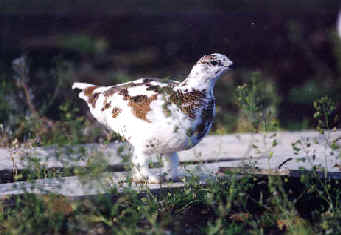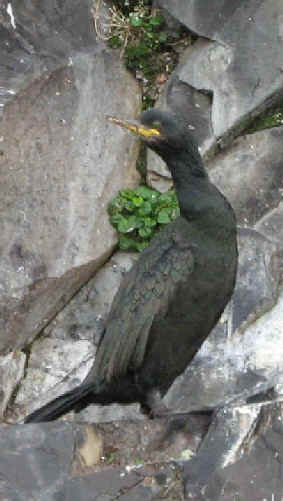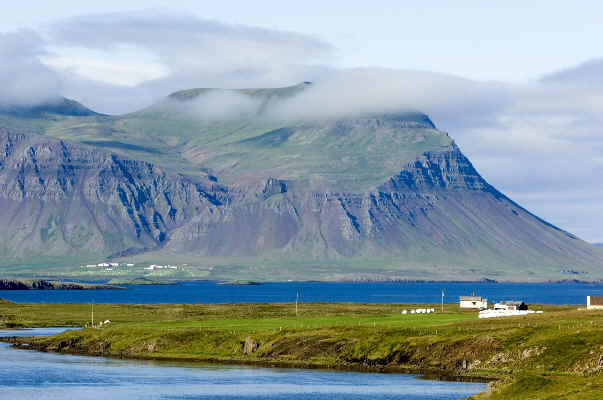
E-mail: font@focusonnature.com
Phone: Toll-free in USA 1-800-721-9986
or 302/529-1876; Fax: 302/529-1085
 |
PO Box 9021,
Wilmington, DE 19809, USA E-mail: font@focusonnature.com Phone: Toll-free in USA 1-800-721-9986 or 302/529-1876; Fax: 302/529-1085 |
THE FONT BIRDING & NATURE TOUR IN ICELAND
September/October 2006

A Rock Ptarmigan
photographed during a FONT tour in Iceland
(photo by Alan Brady)
Links:
List of Birds during the FONT Iceland Tour - Sep/Oct '06
Cumulative List of Birds during our Iceland Tours (with photos)
Complete List of the Birds of Iceland
Cumulative List of Birds during our European Tours (with photos)
Previous Iceland Tour Highlights
Upcoming FONT Birding & Nature Tours in Iceland
The following account written by Armas Hill, leader
of the tour:
There have been 14 FONT birding
& nature tours in Iceland, and oddly, in
a way, most of them have been in the Fall.
Yes, we've also enjoyed Iceland in the late Spring (late May & early
June), and it is wonderful then with all of the breeding birds and the
wildflowers in addition to the fascinating geology and wonderful scenery.
But Iceland in the Fall also has its strong points. The geology and scenery of
course are still there. The days are still long enough. After dark, the "Northern
Lights", or Aurora Borealis,
can be seen dancing in the sky.
FONT started, years ago, going to Iceland in the Fall as
something interesting to do in conjunction with the tour in southern Sweden for
the southbound bird migration. Our Fall Iceland tours, until this one, were in
October. In 2006, we went about a week earlier, being there for the first time
during September, and then spilling a day or
two into October.
In relation to birds, Iceland in the Fall is when some are coming and others are
going, and their paths are in a number of directions. During our Fall
'06 tour, we saw Eurasian Curlews and Bar-tailed Godwit
along the southern Icelandic shoreline. Both species had come from Norway to
spend the winter in Iceland. Nearby, at a pasture with Icelandic Horses,
there were Wheatear and White Wagtail. Those two species were
about to leave Iceland to go to mainland Europe - to Spain, or even to Africa.
From North America, that same day, we saw a Long-billed Dowitcher (an
Icelandic rarity - the 6th record for the island), a Sabine's Gull (a
species that breeds in the Canadian Arctic, and not in far-northern Europe), and
a Snow Goose that joined in other geese. The dowitcher was on a pasture
with European Golden Plovers (they were staging prior to their
migration to the British Isles). The Sabine's Gull was in a flock of
assorted Gulls in a fishing village. In that assemblage there were Black-headed
and Black-backed Gulls, Herring Gulls (of a European race), and Glaucous
and Iceland Gulls. The Glaucous Gulls stay in Iceland year-round,
but the Iceland Gull, it's name notwithstanding, has just arrived from
Greenland. It breeds there, and not in Iceland at all. Some Lesser
Black-backed Gulls were still about, but that species, now abundant in
Iceland during the breeding season, otherwise departs (to southwestern
Europe, and probably elsewhere).
The Snow Goose, mentioned a moment ago, was 1 of 5 species of geese
during our tour. It was the rarest, as we only saw one. It was in with a flock
of Greylag Geese. That's the most commonly seen goose in Iceland,
widespread in the lowlands. The Pink-footed Goose nests in Iceland in the
interior highlands, but our encounter with that species was an interesting one
at sea level. The birds were in a large, tight flock out on a bay. There were
hundreds of birds close together in that group. When we stopped our vehicle, and
even before we exited, the big flock simultaneously did the same, to be further
from us. I read later that such wary behavior is normal for that species,
outside their breeding season. The large flock was soon to go to where the birds
would winter in England, Belgium, and the Netherlands.
In northwestern Iceland, at the entrance to a large fjord, we saw a massive
number of Brant (or Brent Geese as they're called in
Europe). We've seen them staging there during previous years. Those birds,
from Greenland, would continue on their journey to winter in Ireland. What we
had not seen during any of previous Iceland tours, was a flock of Barnacle
Geese, migrating as they do through Iceland in late September into October.
That was because they normally occur in another part of the island where we
don't normally go in the fall. This time, however, we did, and so we saw a large
flock of Barnacle Geese, resting during their migration from Greenland to
Scotland. They were in southeastern Iceland on rather barren terrain where in
the summer more Great Skuas nest than anywhere else. Barnacle Geese
are nice to see. As I looked at them, I thought of how the fluffy young goslings
in Greenland had plummeted down seaside cliffs.
The only normally-occurring goose that we did not see in Iceland during our Fall
'06 tour was the Greater White-fronted, a species that also passes through
Iceland from Greenland to elsewhere. In Iceland, its path is usually through the
southwestern part of the island. Well, we couldn't be everywhere (even though
it could be said we tried!)
During our '06 Fall tour, there were no Great Skuas, where we saw them earlier
in the year during our May/June tour, in barren southeastern Iceland (where,
as just noted, in October we saw the Barnacle Geese).
Actually, during FONT Iceland tours in the past, prior to Oct '06, we'd only
seen Great Skuas in Iceland in the late Spring. But during our Fall 2006
tour, we did enjoy seeing a few Great Skuas in northwestern Iceland,
flying over a fjord where often we've had good birding. It's a fjord where
apparently numerous fish often cause there to be, in our experience,
numerous birds and marine mammals such as seals and whales.
Our Great Skuas in the Fall '06 were seen on the last day of September,
so still we haven't seen a Great Skua in Iceland in October.
The same also applies to the Arctic Tern. During our Fall '06 tour, at
the same fjord, we also saw a few Arctic Terns. When we've been in
Iceland in the late Spring, the Arctic Tern is one of the most abundant birds,
occurring at nest sites throughout the Country. As with the Great Skua, prior to
the fall of '06, we'd never seen an Arctic Tern during that season, and still
have not in October. Of all the Icelandic birds, the Arctic Terns that leave
after they nest travel the furthest. They go south beyond South Africa into the
Indian Ocean and to waters off the west coast of Australia.

A Shag, photographed
during
the FONT Sep/Oct '06 Iceland Tour,
by Claude Bloch
In northwestern Iceland, a picturesque area of bays and islands is the
stronghold in the country for the White-tailed Eagle. During our Fall '06
Tour in that area, we enjoyed sightings of 5 of them. Our first were from a
boat, from which, in addition to the nice scenery, we saw, closely, Shags,
along with flocks of Eider, and, on the water, Black Guillemots,
not-so-black in their non-breeding plumage.
The White-tailed Eagle population in Iceland is not large, with only
about 30 nesting pairs. The first pair that we saw (from the boat) we
were told did not nest successfully in 2006. The species ranges across northern
Eurasia, as far east as northern Japan, as far west as
Greenland.
But is Greenland in Eurasia? No, it's
said by most to be part of North America. So, birds that come to Iceland from
Greenland, such as the geese, various shorebirds, the Wheatear,
the Iceland Gull, and even another race of Black Guillemots that
come for the winter, are, in essence, changing continents.
In Iceland, itself, there are just 3 bird species that are "North
American". They are: the Common Loon (called in Europe the Great
Northern Diver), the Harlequin Duck, and the Barrow's
Goldeneye. None of these nest anywhere else in Europe. Some of the Loons
(or Divers) spend the winter off, for example, the coast of
Scotland. But the Barrow's Goldeneye and Harlequin Duck do not
normally occur anywhere else in Europe.
During our Fall Iceland Tours, we do not usually visit Lake
Myvatan, a large lake in the Icelandic northern highlands that is, in
the late spring and summer a nursery for many ducks. But in the Fall of
'06 we did go there, and found that a number of ducks were still there
too (as the lake had not yet frozen). The Common (or Black)
Scoter, for example, that nests there, was still present. It had not yet
gone to the sea. The Harlequin Ducks that nest by rapids along a rushing
stream near the lake were gone. We had seen them the previous day along the
northern Icelandic seacoast, bobbing about on the ocean, just a very few miles
from the Arctic Circle. Where the Harlequins are in the late spring and summer,
however, we did see something fascinating - a large flock of dozens of male Barrow's
Goldeneyes in the rapids of the stream. Certainly, that was the largest such
grouping of Barrow's Goldeneyes in Europe. It was quite a sight, and with
a background not to be forgotten with volcanic craters, and dark clouds in
sunlight with the most vivid of complete, colorful rainbows.
About an hour or so, further along the road in the highlands, we saw one of the
very few land mammals in Iceland, a Caribou (or Reindeer).
It was a male with a huge rack of antlers - a descendent of animals brought to
Iceland years before from Lappland.
In this narrative, mention has been made of where Iceland birds come from, and
where they go. And the mixture of what's European and American has been noted.
Actually, Iceland, itself, (although a European country) is a mixture of
European and American. It's the only place where the Mid-Atlantic
Rift is above the surface of the ocean. A bridge over the rift, where
it appears as a channel of water, is actually a bridge between continents. And
that's just another thing of what's interesting in Iceland .
Interesting, too, is the Iceland bird-list. Although about 70 species of birds
breed, during the late-spring and summer, in Iceland, and a few other birds
routinely come to spend the winter (such as the curlew &
godwit mentioned earlier), the number of birds on the Iceland list
is substantially more, about 350 species. That's due to the number of rarities
and vagrants that come from either Europe or America.
We look forward to going to Iceland to see what unexpected birds we find. During
our next tour, the FONT Iceland bird-list should top 100 species. As of now (the
end of 2006), we're at 96.

Icelandic scenery, during our Fall
'06 Tour